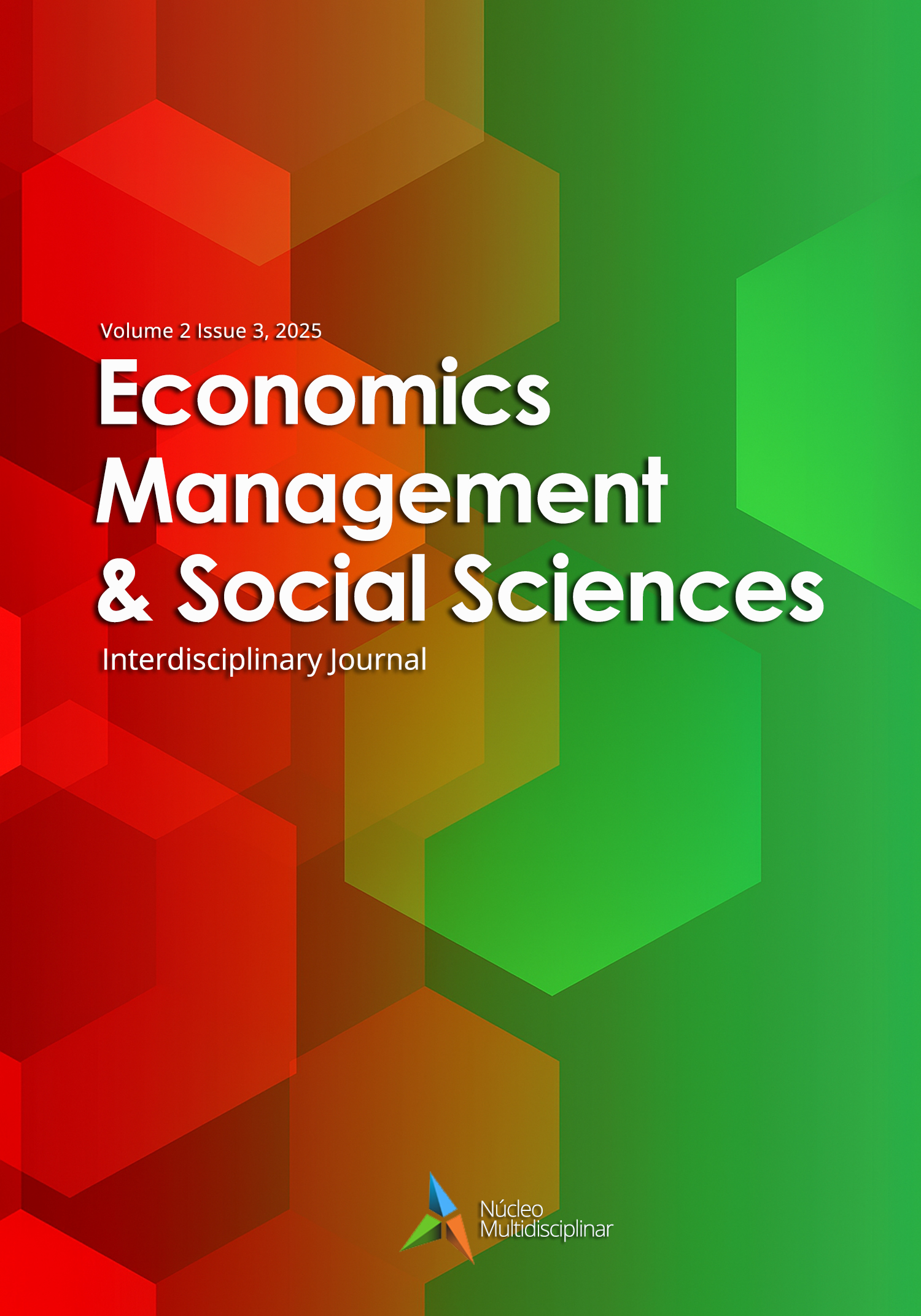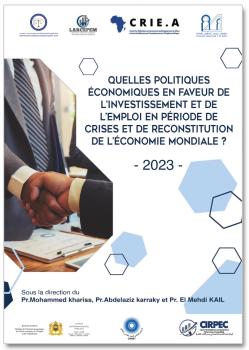Overconfidence vs. Herding
Analyzing Investor Behavior in the Moroccan Retail Trade Sector
Mots-clés :
Overconfidence, herding behavior, Trading Volume, Behavioral Finance, Moroccan Stock MarketRésumé
This study looks at overconfidence and herding in the Moroccan stock market, focusing on the retail trade sector. We use daily data from four major stocks; Autohall, Ennakl, Label Vie, and Total Maroc, covering March 2015 to January 2025. Investor behavior is analyzed with regression and rolling-window methods. Overconfidence is tested by seeing how volatility and past returns affect trading volume, while herding is measured using CSAD metrics for both trading volume and returns.
The results provide strong evidence of overconfidence, particularly in Label Vie and Total Maroc, where volatility coefficients are significantly positive (β = 1.52e+06 and β = 6.17e+05, respectively). These findings confirm that higher volatility encourages excessive trading. Rolling regressions further show that overconfidence is time-varying and becomes more pronounced during volatile market conditions.
By contrast, herding behavior appears largely absent. The squared market volume coefficient (β₂ = -1.512e-12, p = 0.747) and squared return coefficient (β₂ = 4.46, p < 0.01) indicate that dispersion increases rather than contracts during periods of elevated market activity, contradicting the expectations of herding models. Time-varying t-statistics also remain consistently above -2, confirming the lack of persistent herding across the sample period.
Overall, the findings show that Moroccan retail investors are more influenced by their own confidence than by following the crowd.
Références
Abhijith, R., & Bijulal, D. (2024). "Heuristic biases influencing individual stock investment
decisions: A hybrid fuzzy DELPHI-AHP-DEMATEL approach." Journal of Advances in Management Research, 21(4), 627–648. https://doi.org/10.1108/JAMR-03-2024-0093
Ali, U., & Hirshleifer, D. (2017). "Opportunism as a Managerial Trait: Predicting Insider
Trading Profits and Misconduct." Journal of Financial Economics, 126(3), 490-515. https://sites.uci.edu/dhirshle/files/2016/11/SSRN-id2635257.pdf
Alrabadi, D. W. H., & Al-Abdallah, S. Y. (2022). "The roles of financial literacy and
overconfidence in investment decision making: Evidence from Saudi Arabia." Frontiers in Psychology, 13, 1023071. https://doi.org/10.3389/fpsyg.2022.1023071
Barber, B. M., & Odean, T. (2001). "Boys Will Be Boys: Gender, Overconfidence, and
Common Stock Investment." Quarterly Journal of Economics, 116(1), 261-292. https://doi.org/10.1162/003355301556400
Barber, B. M., & Odean, T. (2000). Trading Is Hazardous to Your Wealth: The Common Stock
Investment Performance of Individual Investors. The Journal of Finance, 55(2), 773-806. https://doi.org/10.1111/0022-1082.00226
Benayad, M., & Aasri, F. (2020). The Impact of Behavioral Biases on Investment Decisions
of Moroccan SME Managers. Journal of Behavioral Finance, 11(4), 120. https://www.mdpi.com/2227-7072/11/4/120
Bender, M., Luo, Y., & Salterio, S. (2022). "The Effect of Herding Behavior on Decision:
Moderating Effect of Over-Confidence." International Journal of Economics and Finance, 14(3), 45–59. https://doi.org/10.5539/ijef.v14n3p45
Benos, A. V. (1998). Aggressiveness and survival of overconfident traders. Journal of Financial
Markets, 1(3-4), 353-383. https://doi.org/10.1016/S1386-4181(97)00010-4
Bikhchandani, S., Hirshleifer, D., & Welch, I. (1992). "A Theory of Fads, Fashion, Custom,
and Cultural Change as Informational Cascades." Journal of Political Economy, 100(5), 992-1026. https://doi.org/10.1086/261849
Borah, N., Mbanga, C., & Shoukfeh, S. (2023). Investor Attention, News, and the Herd
Behavior of Individual Stock Returns. Journal of Finance Issues, 21(2), 1-16.
Burnside, C., Han, B., Hirshleifer, D., & Wang, T. Y. (2011). "Investor Overconfidence and
the Forward Premium Puzzle." Review of Economic Studies, 78(2), 523-558. https://doi.org/10.1093/restud/rdq027
Chang, E. C., Cheng, J. W., & Khorana, A. (2000). "An Examination of Herd Behavior in
Equity Markets: An International Perspective." Journal of Banking & Finance, 24(10), 1651-1679. https://doi.org/10.1016/S0378-4266(99)00096-5
Christie, W. G., & Huang, R. D. (1995). "Following the Pied Piper: Do Individual Returns
Herd around the Market?" Financial Analysts Journal, 51(4), 31-37. https://doi.org/10.2469/faj.v51.n4.1918
Daniel, K., & Hirshleifer, D. (2015). Overconfident Investors, Predictable Returns,
Excessive Trading. Journal of Economic Perspectives, 29(4), 61-88.
https://doi.org/10.3386/w21945
Daniel, K., Hirshleifer, D., & Subrahmanyam, A. (1998). Investor Psychology and Security
Market Under‐ and Overreactions. Journal of Finance, 53(6), 1839-1885. https://doi.org/10.1111/0022-1082.00077
Gavriilidis, K., Kallinterakis, V., & Ferreira, M. P. (2020). "Institutional Industry Herding:
Intentional or Spurious?" Journal of International Financial Markets, Institutions and Money, 65, 101188. https://doi.org/10.1016/j.intfin.2020.101188
Glaser, M., Langer, T., & Weber, M. (2013). True overconfidence in interval estimates:
Evidence based on a new meas-ure of miscalibration. Journal of Behavioral Decision Making, 26(5), 405–417. https://doi.org/10.1002/bdm.1773
Halim, Z., & Pamungkas, P. (2023). "Behavioral Finance Biases and Investment Decisions:
Evidence from Emerging Markets." Journal of Behavioral Finance, 24(3), 321–335. https://doi.org/10.1080/15427560.2023.1934567
Halim, R., & Pamungkas, A. S. (2023). "The Influence of Risk Perception, Overconfidence,
and Herding Behavior on Investment Decision." International Journal of Application on Economics and Business, 1(1), 29-39. https://doi.org/10.24912/ijaeb.11.521-5
Hirshleifer, D., & Shumway, T. (2003). "Good Day Sunshine: Stock Returns and the Weather.
Journal of Finance, 58(3), 1009-1032. https://doi.org/10.1111/1540-6261.00556
Hirshleifer, D., Lim, S. S., & Teoh, S. H. (2009). "Driven to Distraction: Extraneous Events
and Underreaction to Earnings News." Journal of Finance, 63(5), 2287-2323.
https://doi.org/10.1111/j.1540-6261.2009.01501.x
Huang, J., Hudson, R., & Green, C. (2020). "Herd Behavior and Analyst Forecasts in the
UK. International Review of Financial Analysis, 70, 101500.
https://doi.org/10.1016/j.irfa.2020.101500
Hsu, Y.-L. (2022). Financial advice seeking and behavioral bias. Finance Research Letters,
,102505. https://doi.org/10.1016/j.frl.2021.102505
Kahneman, D., & Riepe, M. W. (1998). Aspects of investor psychology. Journal of Portfolio
Management, 24(4), 52. Retrieved from
https://www.pm-research.com/content/iijpormgmt/24/4/52
Kumar, J., & Prince, N. (2022). Overconfidence bias in the Indian stock market in diverse
market situations: An empir-ical study. International Journal of System Assurance
Engineering and Management, 13(6), 3031–3047. https://doi.org/10.1007/s13198-022-01792-1
Koma, D. R. A., & Jatiningsih, D. E. S. (2024). "The Effect of Overconfidence Bias, Risk
Tolerance, and Herding Bias on Stock Investment Decisions with Financial Literacy as a Moderating Variable." BESS 2023: The 3rd International Conference on Business, Economics, and Sustainability Science, 2024, 320-332.
https://doi.org/10.18502/kss.v9i21.16718
Larrick, R. P., Burson, K. A., & Soll, J. B. (2007). Social comparison and confidence: When
thinking you’re better thanaverage predicts overconfidence (and when it does not). Organizational Behavior and Human Decision Processes,102(1), 76–94.
https://doi.org/10.1016/j.obhdp.2006.10.002
Lebdaoui, A., Rabaoui, A., & Khouas, F. (2016). Behavioral Biases and Investment
Performance: Evidence from Moroccan Investors. International Journal of Financial Studies, 4(3), 50-70.
https://www.econjournals.com.tr/index.php/ijefi/article/view/11318
Marietza, F., Nurazi, R., Santi, F., & Saiful, S. (2021). "Bibliometric Analysis Of Herding
Behavior In Times Of Crisis." Journal of Behavioral Finance, 22(3), 234-250.
https://doi.org/10.48550/arXiv.2106.13598
Merkle, C. (2017). Financial overconfidence over time: Foresight, hindsight, and insight of
investors. Journal of Banking & Finance, 84, 68-87.
https://doi.org/10.1016/j.jbankfin.2017.07.009
Nair, P. S., & Shiva, A. (2023). Specifying and validating overconfidence bias among retail
investors: A formative index. Managerial Finance, 50(5), 1017–1036.
https://doi.org/10.1108/MF-04-2023-0237
Nguyen, A. P. N., Conlon, T., Crane, M., & Bezbradica, M. (2024). "Herding Unmasked:
Insights into Cryptocurrencies, Stocks and US ETFs." Journal of Financial Markets, 58, 100789. https://doi.org/10.1016/j.finmar.2024.100789
Nosić, A., & Weber, M. (2010). How Riskily Do I Invest? The Role of Risk Attitudes, Risk
Perceptions, and Overconfidence. Decision Analysis, 7(3), 282-301.
https://doi.org/10.1287/deca.1100.0178
Odean, T. (1998a). Are Investors Reluctant to Realize Their Losses? The Journal of Finance,
(5), 1775-1798. https://doi.org/10.1111/0022-1082.00072
Odean, T. (1998b). Volume, volatility, price, and profit when all traders are above average. The
Journal of Finance, 53(6), 1887-1934. https://doi.org/10.1111/0022-1082.00078
Pak, T.-Y., & Chatterjee, S. (2016). Aging, overconfidence, and portfolio choice. Journal of
Behavioral and Experimental Finance, 12, 112-122.
https://doi.org/10.1016/j. jbef.2016.10.003
Patwarani, R., & Husodo, Z. (2023). Examining Herding Behaviour and Its Impact on Stock
Market Volatility: Insights from Asian Economies. Journal of Theory and Applied Management, 16(3), 596–611. https://doi.org/10.20473/jmtt.v16i3.51757
Sharma, A., & Prajapati, B. (2024). "A Study of Overconfidence Bias on Investment Decision
with Respect to Behavioral Finance." International Journal of Research in Commerce and Management, 11(2), 45-56. https://doi.org/10.1234/ijrcm.v11i2.5678
Sifouh, S., El Omari, A., & Ababou, A. (2017). Overconfidence and Market Volatility:
Evidence from the Casablanca Stock Exchange. European Journal of Economics and Management, 13(2), 100-112. https://eujournal.org/index.php/esj/article/view/11478
Soll, J. B. (1996). Determinants of overconfidence and miscalibration: The roles of random
error and ecological struc-ture. Organizational Behavior and Human Decision Processes, 65(2), 117–137. https://doi.org/10.1006/obhd.1996.0011
Wang, Y., Fan, Y., & Li, H. (2022). Gauging the effect of investor overconfidence on trading
volume from the perspective of the relationship between lagged stock returns and current trading volume. International Finance, 25(1), 103-123.
https://doi.org/10.1111/infi.12405
Wijaya, L. I., Sutejo, B. S., & Tanumulya, G. N. (2024). "The Power of Overconfidence and
Herding Bias, Investment Sentiment, Over/Underreaction in Influencing SDGs from Investment Decisions." Journal of Lifestyle and SDGs Review, 5(2), e02485. https://doi.org/10.47172/2965-730X.SDGsReview.v5.n02.pe02485
Zainul, Zaida & Suryani, Irma. (2021). Identification of Herding Behavior, Overconfidence
and Risk Tolerance Based on Gender Perspective on Stock Investors in Aceh. 6th International Conference on Tourism, Economics, Accounting, Management, and Social Science. https://doi.org/10.2991/aebmr.k.211124.024.
Publiée
Comment citer
Numéro
Rubrique
Licence
(c) Tous droits réservés Mohamed Amine CHAFIK, Faouzi BOUSSEDRA, Adda BENSLIMANE, Julio LOBÃO 2025

Ce travail est disponible sous licence Creative Commons Attribution - Pas d’Utilisation Commerciale 4.0 International.







